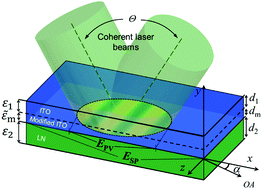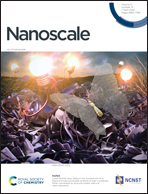Multi-frequency surface plasmons supported with a nanoscale non-uniform 2D electron gas formed due to a polar catastrophe at the oxide interface, dispersions, diffractions, and beyond†
Abstract
Recently, 2D electron gases (2DEGs) formed at oxide interfaces are drawing increasing attention as they cause a myriad of intriguing phenomena. As ideal platforms in supporting surface plasmon polaritons (SPPs) without metallic constituents, such 2DEGs are favorable in non-linear plasmonics for ultra-low total Joule dissipation. Convincingly, an increase in the interfacial electron density (IIED) formed at the interface of indium–tin-oxide and LiNbO3 composite slab is responsible for a number of interesting phenomena, which are hardly explained with the conventional photorefractive theoretical framework but can be satisfactorily elucidated via SPP excitation and resultant colossal non-linear effects. Since the polar-catastrophe-led IIED is universal to all combinations of highly polar ferroelectric oxides (FOs) and less polar transparent conducting oxides (TCOs), a systematic theoretical treatment of an FO/TCO system is pivotal to a variety of promising applications. In this study, the nanometer scale 2DEG at the FO/TCO interface is illustrated theoretically with the Thomas–Fermi screening picture, by taking into account the spontaneous polarization, along with related boundary conditions. The local plasma frequency of 2DEGs can be increased up to the UV regime for the composite slabs discussed, which are suitable for highly desirable visible applications. The SPP dispersion relationship was given for the 2DEG layer sandwiched between the FO slab and the unmodified TCO layer. To further take the non-uniform nature of IIED into account, dramatic dispersions of dielectric permittivity and index of refraction were simulated with a very broad range, hinting at different ways for meeting phase matching conditions and slowing the light for non-linear plasmonic applications, which are confirmed experimentally.



 Please wait while we load your content...
Please wait while we load your content...